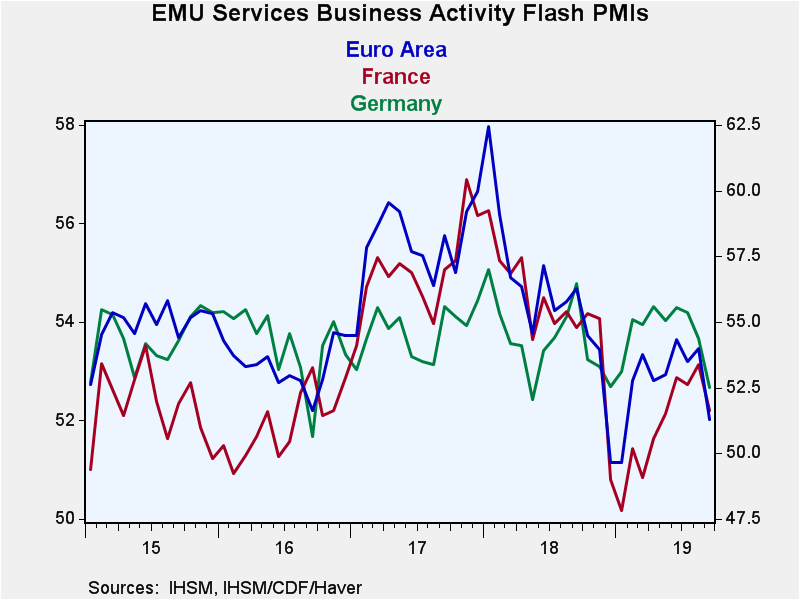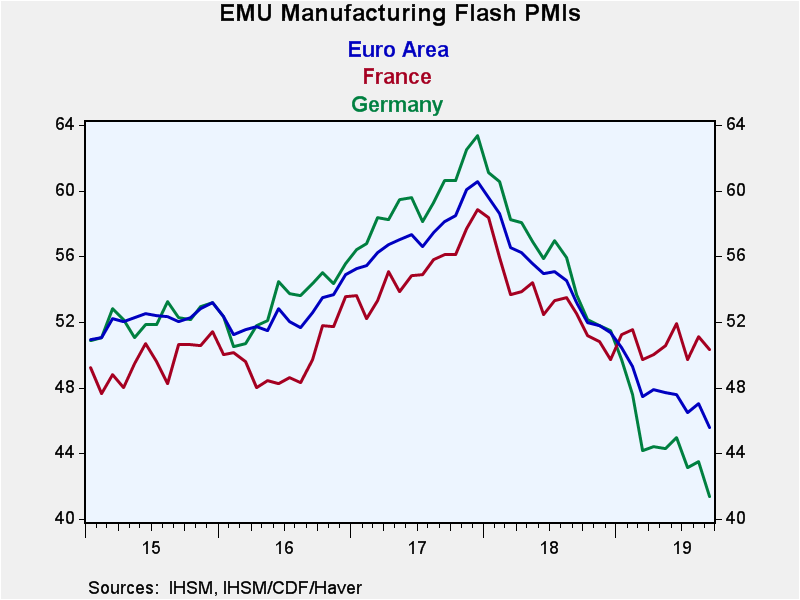 Global| Sep 23 2019
Global| Sep 23 2019PMIs Show Weakness Relapse in Europe
Summary
The flash EMU composite PMI has fallen to 50.4 in September from 51.8 in August. This is a substantial drop of 1.4 points month-to-month. Since February 2015, the average monthly change (in absolute value) in the composite PMI has [...]
The flash EMU composite PMI has fallen to 50.4 in September from 51.8 in August. This is a substantial drop of 1.4 points month-to-month. Since February 2015, the average monthly change (in absolute value) in the composite PMI has been +/- 0.6 points; one standard deviation is 0.47 points. The monthly drop is just within the two standard deviation band of the mean change for the period. With the ECB pulling out all the stops (that it can pull, at least politically) and with the German economy clearly weak and weakening, the new slippage after the PMIs had showed signs of slowing their drop and even of increasing in the services sector- has gone away. Today outgoing ECB President Mario Draghi said that there is no evidence of a euro area rebound. Well! That is not progress. Certainly, the new ECB policies have not had a chance to work. And by their very nature, they are going to be more supportive and nurturing than strikingly trend-changing. But there is some help on the way; it’s just looking like there may be more ‘need’ than there is ‘help.’
The service sector indexes for France, Germany and the EMU have fallen significantly after logging a period of sustained increases from intermediate cycle lows around the end of last year. The manufacturing indexes have had only some slight slowing in their weakness as the second chart makes clear. The slope of the PMI fall in manufacturing was more severe from end-2017 to end-2018 compared to the slope from the end of 2018 to date (to use general timing benchmarks). But now for Germany, the pace of decline has stepped up again and that helps to step up the pace of decline for the EMU index as well. The French index is still waffling and even has a slight uptrend from its recent low made in late-2018. Still, there is not much there to turn your head and France’s services sector also took a substantial step lower in September.
The standings of the EMU PMI gauges are low. The PMI composite is on its low since January 2015; manufacturing on its low since 2015 and the services sector at a 3.6 percentile standing is barely up from its low of this period. Germany has its composite at its period low with manufacturing also at its period low and services at its 3.6 percentile-still very weak. France shows a composite standing at its 26.8 percentile with manufacturing at its 33.9 percentile and services relatively lower than manufacturing at its 28.6 percentile.
U.S. PMI data from Markit today shows a slightly opposite trend with a composite ticking higher to 51.0 in September from 50.9 in August. Manufacturing is moving back to expansion to a reading of 51.0 from 49.9 and the services reading is unchanged at 50.9. The U.S. diffusion composite reading is stronger than the EMU reading on a stronger manufacturing sector although the U.S. service sector reading is weaker (both services sectors, however, have the same relative standing in terms of their percentile standing at 3.6%).
PMI data are important but not definitive. Their advantage is that they can be very timely and are available well ahead of conventional ‘accounting data.’ Accounting data like GDP, industrial production and retail sales must be counted up by a participant sent to a central source and then that central agency needs to massage the data to deal with seasonal adjustment and to fill in holes from non-reporters. This is sort of grass roots data takes more time to collect, but it tells us more. The diffusion indexes are only about the breadth of increases, not about their strength. Still, breadth and strength are usually closely related. PMI indexes also are sensitive to changes in the forces driving the economy. This month the European PMIs pick up a backtracking to weakness that reversed a recovery theme. The PMI signals this month raise more warning signs. For the U.S. the opposite is true. U.S. data show some calm but still are clinging to very weak levels of activity. When we compare the composite PMI data from Markit to other surveys and to accounting data, we are not getting two different stories. We are largely getting one story. It is not yet about how the sky is falling…but it may yet be that.
Robert Brusca
AuthorMore in Author Profile »Robert A. Brusca is Chief Economist of Fact and Opinion Economics, a consulting firm he founded in Manhattan. He has been an economist on Wall Street for over 25 years. He has visited central banking and large institutional clients in over 30 countries in his career as an economist. Mr. Brusca was a Divisional Research Chief at the Federal Reserve Bank of NY (Chief of the International Financial markets Division), a Fed Watcher at Irving Trust and Chief Economist at Nikko Securities International. He is widely quoted and appears in various media. Mr. Brusca holds an MA and Ph.D. in economics from Michigan State University and a BA in Economics from the University of Michigan. His research pursues his strong interests in non aligned policy economics as well as international economics. FAO Economics’ research targets investors to assist them in making better investment decisions in stocks, bonds and in a variety of international assets. The company does not manage money and has no conflicts in giving economic advice.








